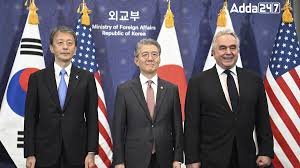Cabinet Approves India-USAID MoU for Railways’ Net Zero Emission Goal
The Indian Cabinet recently sanctioned the Memorandum of Understanding (MoU) between India and the United States Agency for International Development (USAID) to bolster the Indian Railways’ ambition of achieving a net-zero carbon emission status by 2030. This pact, a pivotal step in the direction of sustainable infrastructure, aims to leverage American technological expertise and financial support to assist India in its green railway initiatives.
The collaboration is poised to bring forth advanced technology and innovative solutions to modernize the railway infrastructure in India. It will focus on fostering the deployment of energy-efficient technologies, including electric locomotives, biofuels, and renewable energy sources, minimizing the carbon footprint in the country’s extensive railway network.

Why this News is Important:
India’s Environmental Commitment: India’s commitment to achieving net-zero carbon emissions by 2030 through collaborations like the India-USAID MoU signifies the country’s dedication to combatting climate change and promoting sustainable development. Such initiatives reflect a proactive stance towards environmental conservation and cleaner energy practices.
Technological Advancements: The collaboration with USAID promises to bring in advanced technology and innovative solutions to modernize India’s railway infrastructure. This infusion of technology is pivotal in transitioning towards energy-efficient and eco-friendly modes of transportation.
Historical Context:
The history of India’s railway system dates back to the British colonial era when the first passenger train commenced its journey from Mumbai to Thane in 1853. Since then, the railway network has expanded exponentially, becoming a lifeline for transportation across the country. Over the years, India has made strides in modernizing its railways, introducing electrification and other technological advancements.
Key Takeaways from “Cabinet Approves India-USAID MoU for Railways’ Net Zero Emission Goal”:
| Serial Number | Key Takeaway |
|---|---|
| 1. | India and USAID have signed an MoU for railway emissions. |
| 2. | Aim: Achieve net-zero carbon emissions in Indian Railways by 2030. |
| 3. | Collaboration to introduce energy-efficient technologies. |
| 4. | Modernization of railway infrastructure is a significant focus. |
| 5. | Emphasis on global cooperation for sustainable development. |
Important FAQs for Students from this News
Q: What is the aim of the MoU between India and USAID for the railways?
A: The aim is to achieve net-zero carbon emissions in Indian Railways by 2030.
Q: What technologies are expected to be introduced through this collaboration?
A: Energy-efficient technologies such as electric locomotives, biofuels, and renewable energy sources will be introduced.
Q: Why is the collaboration between India and USAID significant?
A: It signifies global cooperation for sustainable development and showcases a commitment to combat climate change.
Q: What historical significance does the Indian railway system hold?
A: The Indian railway system, dating back to the British colonial era, has been pivotal in the country’s transportation network and has undergone significant modernization.
Q: How might this collaboration impact India’s railway infrastructure?
A: The collaboration is expected to modernize the infrastructure, introducing greener and more sustainable practices.
Some Important Current Affairs Links


















